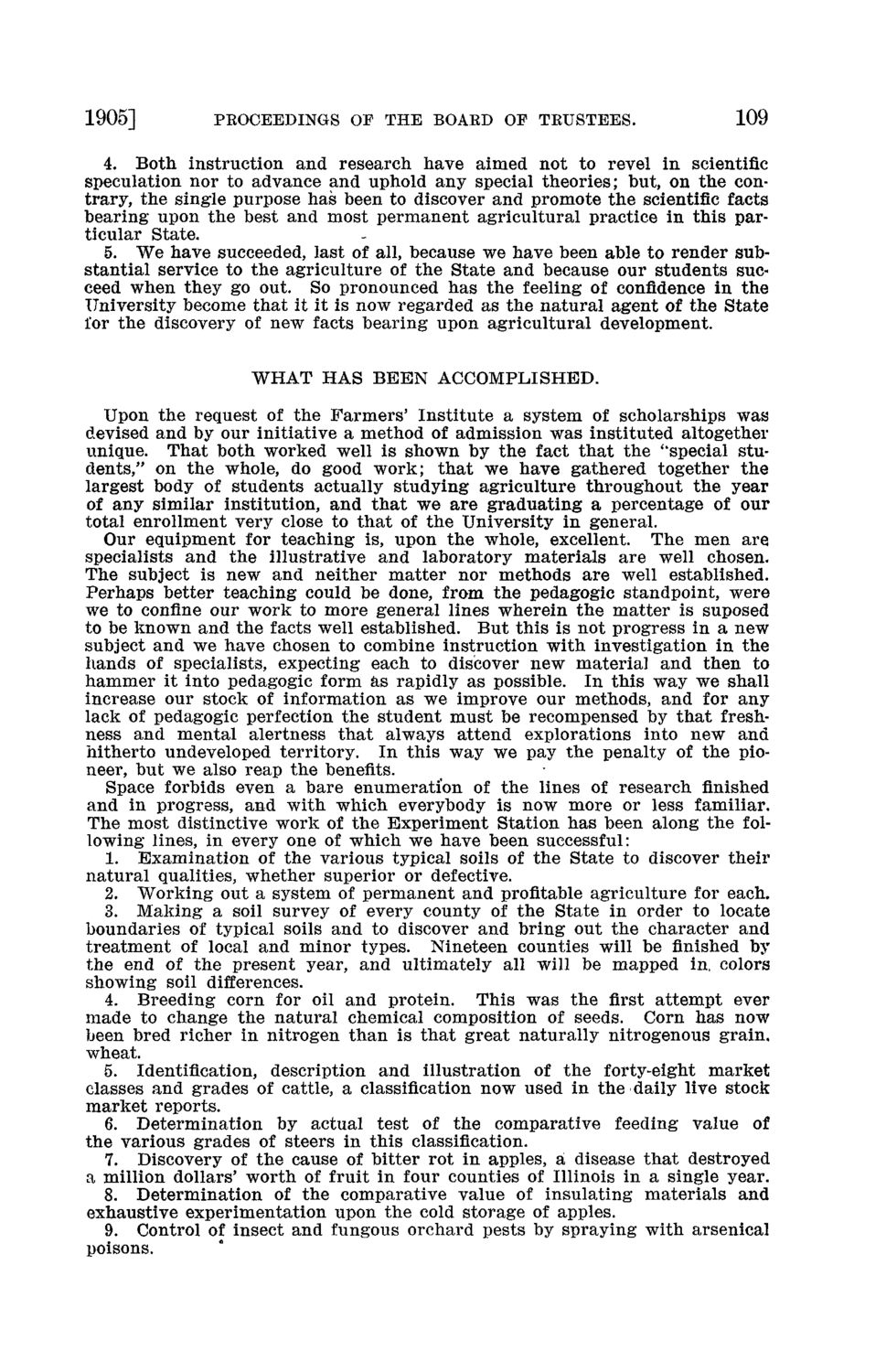| |
| |
Caption: Board of Trustees Minutes - 1906
This is a reduced-resolution page image for fast online browsing.

EXTRACTED TEXT FROM PAGE:
1905] PEOCEEDINGS OF THE BOAED OF TEUSTEES. 109 4. Both instruction and research have aimed not to revel in scientific speculation nor to advance and uphold any special theories; but, on the contrary, the single purpose has been to discover and promote the scientific facts bearing upon the best and most permanent agricultural practice in this particular State. 5. We have succeeded, last of all, because we have been able to render substantial service to the agriculture of the State and because our students succeed when they go out. So pronounced has the feeling of confidence in the University become that it it is now regarded as the natural agent of the State for the discovery of new facts bearing upon agricultural development. WHAT HAS BEEN ACCOMPLISHED. Upon the request of the Farmers' Institute a system of scholarships was devised and by our initiative a method of admission was instituted altogether unique. That both worked well is shown by the fact that the "special students," on the whole, do good work; that we have gathered together the largest body of students actually studying agriculture throughout the year of any similar institution, and that we are graduating a percentage of our total enrollment very close to that of the University in general. Our equipment for teaching is, upon the whole, excellent. The men are specialists and the illustrative and laboratory materials are well chosen. The subject is new and neither matter nor methods are well established. Perhaps better teaching could be done, from the pedagogic standpoint, were we to confine our work to more general lines wherein the matter is suposed to be known and the facts well established. But this is not progress in a new subject and we have chosen to combine instruction with investigation in the hands of specialists, expecting each to discover new material and then to hammer it into pedagogic form as rapidly as possible. In this way we shall increase our stock of information as we improve our methods, and for any lack of pedagogic perfection the student must be recompensed by that freshness and mental alertness that always attend explorations into new and hitherto undeveloped territory. In this way we pay the penalty of the pioneer, but we also reap the benefits. Space forbids even a bare enumeration of the lines of research finished and in progress, and with which everybody is now more or less familiar. The most distinctive work of the Experiment Station has been along the following lines, in every one of which we have been successful: 1. Examination of the various typical soils of the State to discover their natural qualities, whether superior or defective. 2. Working out a system of permanent and profitable agriculture for each. 3. Making a soil survey of every county of the State in order to locate boundaries of typical soils and to discover and bring out the character and treatment of local and minor types. Nineteen counties will be finished by the end of the present year, and ultimately all will be mapped in. colors showing soil differences. 4. Breeding corn for oil and protein. This was the first attempt ever made to change the natural chemical composition of seeds. Corn has now been bred richer in nitrogen than is that great naturally nitrogenous grain, wheat. 5. Identification, description and illustration of the forty-eight market classes and grades of cattle, a classification now used in the daily live stock market reports. 6. Determination by actual test of the comparative feeding value of the various grades of steers in this classification. 7. Discovery of the cause of bitter rot in apples, a disease that destroyed a million dollars' worth of fruit in four counties of Illinois in a single year. 8. Determination of the comparative value of insulating materials and exhaustive experimentation upon the cold storage of apples. 9. Control of insect and fungous orchard pests by spraying with arsenical poisons.
| |